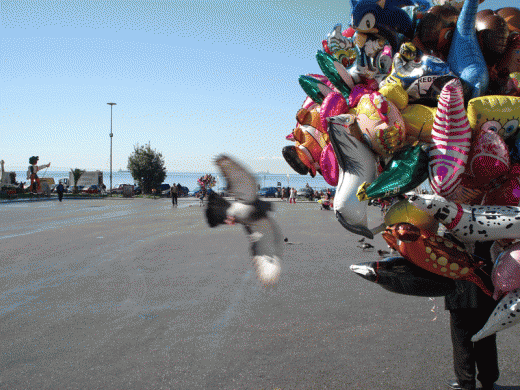|
|
||
|
Pro Tools
FILMFESTIVALS | 24/7 world wide coverageWelcome ! Enjoy the best of both worlds: Film & Festival News, exploring the best of the film festivals community. Launched in 1995, relentlessly connecting films to festivals, documenting and promoting festivals worldwide. We are currently working actively to upgrade this platform, sorry for the inconvenience. For collaboration, editorial contributions, or publicity, please send us an email here. User login |
History of Thessaloniki with a few wordsThe city was founded around 315 BC by the King Cassander of Macedon, on or near the site of the ancient town of Therma and twenty-six other local villages. He named it after his wife Thessalonike, a half-sister of Alexander the Great (Thessalo-nikē means the "victory of Thessalians"). It was an autonomous part of the Kingdom of Macedon. After the fall of the kingdom of Macedon in 168 BC, Thessalonica became a city of the Roman Republic. It grew to be an important trade-hub located on the Via Egnatia and facilitating trade between Europe and Asia. The city became the capital of one of the four Roman districts of Macedonia. When in 379 the Roman Prefecture of Illyricum was divided between East and West Roman Empires, Thessaloníki became the capital of the new Prefecture of Illyricum. The economic expansion of the city continued through the twelfth century as the rule of the Komnenoi emperors expanded Byzantine control to the north. Thessaloniki passed out of Byzantine hands in 1204, when Constantinople was captured by the Fourth Crusade. Thessaloníki and its surrounding territory-the Kingdom of Thessalonica-became the largest fief of the Latin Empire. The city was recovered by the Byzantine Empire in 1246 sold it in 1423 to Venice, which held the city until it was captured by the Ottoman Sultan Murad II on 29 March 1430. During the Ottoman period, the city's Muslim and Jewish population grew. By 1478, Thessaloniki had a population of 4,320 Muslims and 6,094 Greek Orthodox, as well as some Catholics, but no Jews. By ca. 1500, the numbers had grown to 7,986 Greeks, 8,575 Muslims, and 3,770 Jews, but by 1519, there were 15,715, 54% of the city's population. The invitation of the Sephardic Jews expelled from Spain by Ferdinand and Isabella, was an Ottoman demographic strategy aiming to prevent the Greek element from dominating the city.[5] The city remained the largest Jewish city in the world for at least two centuries, often called "Mother of Israel". During the First Balkan War, the Ottoman garrison surrendered Salonika to the Greek Army, on November 9 November [O.S. 27 October] 1912. In 1915, during World War I, a large Allied expeditionary force landed at Thessaloniki as the base for a massive offensive against pro-German Bulgaria. In 1916, pro-Venizelist army officers, with the support of the Allies, launched the Movement of National Defence, which resulted in the establishment of a pro-Allied temporary government that controlled northern Greece and the Aegean, against the official government of the King in Athens, which lead the city to be dubbed as symprotévousa ("co-capital"). Most of the old town was destroyed by a single fire on 18 August [O.S. 5 August] 1917, accidentally sparked by French soldiers in encampments at the city. The fire left some 72,000 homeless, many of them Turkish, of a population of approximately 271,157 at the time. Thessaloniki fell to the forces of Nazi Germany on April 22, 1941, and remained under German occupation until 30 October 1944. The city suffered considerable damage from Allied bombing, and almost its entire Jewish population was exterminated by the Nazis. Barely a thousand Jews survived. Thessaloniki was rebuilt and recovered fairly quickly after the war with large-scale development of new infrastructure and industry throughout the 1950s, 1960s and 1970s. On 20 June 1978, the city was hit by a powerful earthquake, registering a moment magnitude of 6.5. The tremor caused considerable damage to several buildings and even to some of the city's Byzantine monuments; forty people were crushed to death when an entire apartment block collapsed in the central Hippodromio district. Early Christian and Byzantine monuments of Thessaloniki were inscribed on the UNESCO World Heritage list in 1988, and Thessaloniki later became European City of Culture 1997. In 2004 the city hosted a number of the football events forming part of the 2004 Summer Olympics. Thessaloniki unsuccessfully bid for the 2008 World EXPO, this time won by Zaragoza in Spain, but another planned bid for 2017 was announced in September 2006 and is now in full development.
14.03.2008 | Thessaloniki's blog Cat. : 1st millennium BC Alexander Asia Athens Byzantine Empire Cassander Europe European City Greece Greek Army history Illyricum Macedonia Mediterranean Politics Politics Roman Empires Spain Sultan Murad II Technology Technology Therma Thessalonike Thessalonike of Macedon thessaloniki Thessaloniki Tourism in Greece United Nations Educational Scientific and Cultural Organization Venice War War Travel & acc.
|
LinksThe Bulletin Board > The Bulletin Board Blog Following News Interview with EFM (Berlin) Director
Interview with IFTA Chairman (AFM)
Interview with Cannes Marche du Film Director
Filmfestivals.com dailies live coverage from > Live from India
Useful links for the indies: > Big files transfer
+ SUBSCRIBE to the weekly Newsletter DealsUser imagesAbout Thessaloniki Mcmahon Vanessa Mcmahon Vanessa Vanessa McMahon Covered the 13th and 14th, and 16th edition. Through its tributes, it focuses both on discovering filmmakers with a unique cinematic point of view, and on the internationally recognized for their contribution to documentary. Contributions from Buno Chatelin http://tdf.filmfestival.gr/default.aspx?lang=en-US&loc=6&page=760 View my profile Send me a message My festivalThe EditorUser contributions |
































